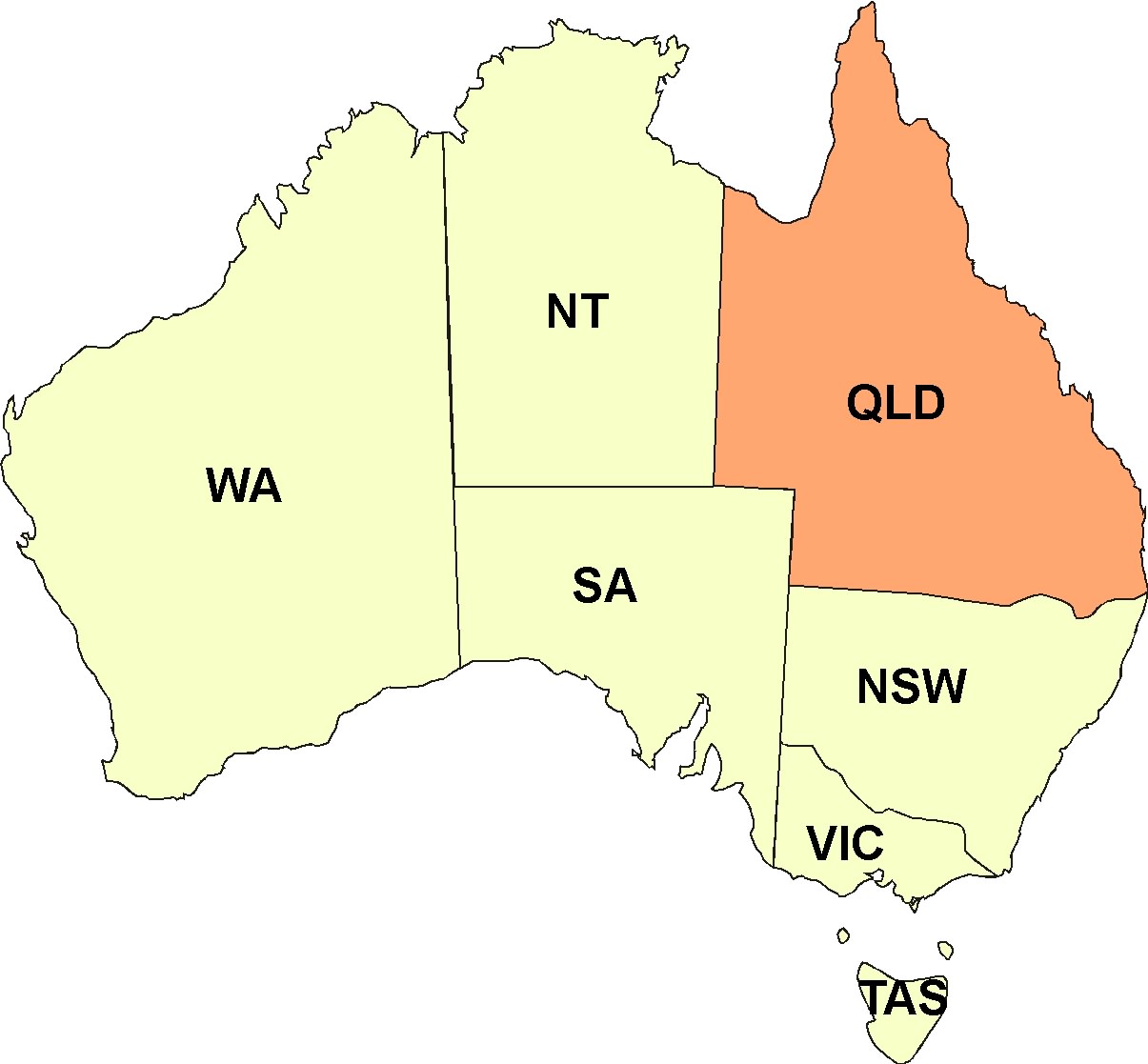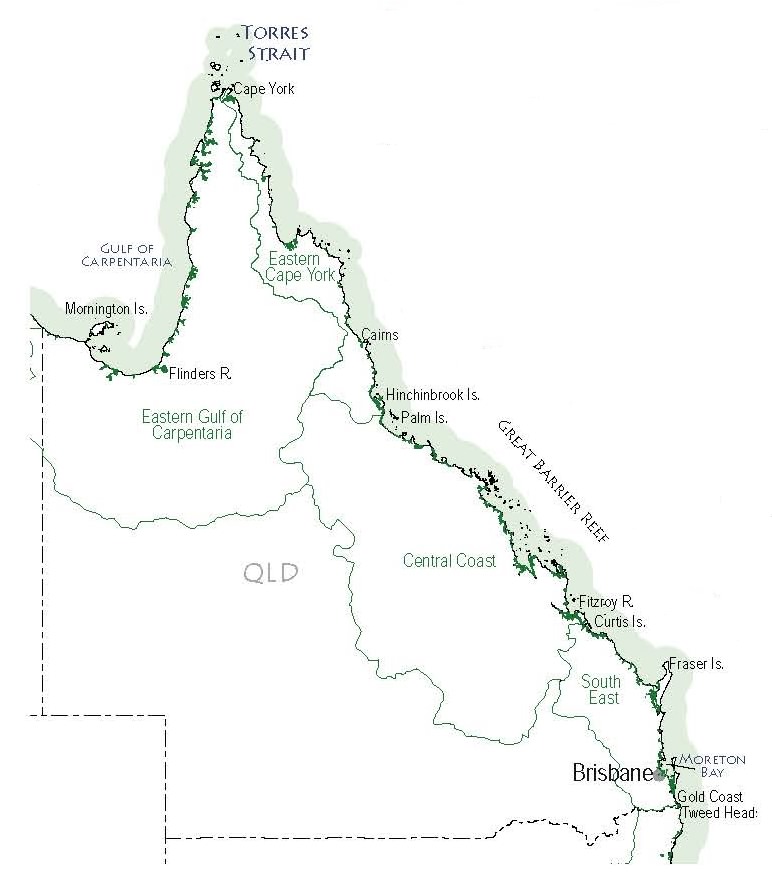 Queensland, Australia
Queensland, Australia
Mangroves in Queensland inhabit a diverse range of coastal and estuarine environments, notably present in around 18% of the 13,347 km coastline. Climatic conditions vary widely reflecting the 18º spread of latitude covered by the state. Regional climates are characterised by warm to hot monsoonal summers that can at times be quite dry, and sometimes very wet.
For more species details see the 2006 book Or, check out the MangroveWatch apps!
Active Local Groups with MangroveWatch Training
Queensland MangroveWatch groups include:
- Northern Torres Straits – TSRA Rangers
- Eastern Princess Charlotte Bay – Rangers
- Cairns region – CAFNEC community
- South Eastern Gulf of Carpentaria – Normanton & Burketown CLCAC Rangers
- Port Curtis & the Southern GBR Coast
- Moreton Bay & Islands
- Logan MangroveWatch
If you are interested in starting a group fill out the form below;
2018 List of Mangrove Plant Species in Queensland
– their presence noted for 4 catchment regions (see Map above)
- Acanthus ebracteatus subsp. ebarbatus – EG
- Acanthus ebracteatus subsp. ebracteatus – EC
- Acanthus ilicifolius – EG, EC, CQ
- Acrostichum aureum – EC
- Acrostichum speciosum – EG, EC, CQ, SE
- Aegialitis annulata – EG, EC, CQ, SE
- Aegiceras corniculatum – EG, EC, CQ, SE
- Avicennia marina var. australasica – CQ, SE
- Avicennia marina var. eucalyptifolia – EG, EC, CQ
- Avicennia officinalis – EC
- Barringtonia racemosa – EG, EC
- Bruguiera cylindrica – EG, EC
- Bruguiera exaristata – EG, EC, CQ
- Bruguiera gymnorhiza – EG, EC, CQ, SE
- Bruguiera hainesii – EC
- Bruguiera parviflora – EG, EC, CQ
- Bruguiera rhynchopetala – EC
- Bruguiera sexangula – EG, EC
- Camptostemon schultzii – EG, EC
- Ceriops australis – EG, EC, CQ, SE
- Ceriops pseudodecandra – EG, EC
- Ceriops tagal – EG, EC, CQ
- Cynometra iripa – EG, EC, CQ
- Diospyros littorea – EG, EC
- Dolichandrone spathacea – EG, EC
- Excoecaria agallocha var. agallocha – EG, EC, CQ, SE
- Heritiera littoralis – EG, EC, CQ
- Lumnitzera littorea – EG, EC
- Lumnitzera racemosa – EG, EC, CQ, SE
- Lumnitzera rosea – EC
- Nypa fruticans – EG, EC
- Osbornia octodonta – EG, EC, CQ, SE
- Pemphis acidula – EG, EC, CQ, SE
- Rhizophora annamalayana – EG, EC
- Rhizophora apiculata – EG, EC, CQ
- Rhizophora lamarckii – EG, EC, CQ
- Rhizophora mucronata – EG, EC
- Rhizophora stylosa – EG, EC, CQ, SE
- Scyphiphora hydrophylacea – EG, EC, CQ, SE
- Sonneratia alba – EG, EC, CQ
- Sonneratia caseolaris – EG, EC
- Sonneratia gulngai – EG, EC
- Sonneratia lanceolata – EC
- Sonneratia ovata – EC
- Xylocarpus granatum – EG, EC, CQ, SE
- Xylocarpus moluccensis – EG, EC, CQ, SE
You can find out more detail about these species from our book and smart device apps
More Information
 The dominant feature of the north-east is the Great Barrier Reef which shelters the coast from high energy wave action. In the south-east, the coast is further protected by an extensive chain of sand islands forming extensive, sheltered coastal channels ideal for mangrove development. In the north-west, the expansive shallow gulf of the Gulf of Carpentaria provides a broad further sheltered enclave. West and east coasts are separated by an eroding mountain divide, the Great Dividing Range that diminishes north to form Cape York Peninsula with its tip in Torres Strait. Over eons, runoff to both sides of this divide has deposited silt to form extensive tidal flats at numerous river mouths, completing the setting for flourishing and extensive mangrove communities around the state.
The dominant feature of the north-east is the Great Barrier Reef which shelters the coast from high energy wave action. In the south-east, the coast is further protected by an extensive chain of sand islands forming extensive, sheltered coastal channels ideal for mangrove development. In the north-west, the expansive shallow gulf of the Gulf of Carpentaria provides a broad further sheltered enclave. West and east coasts are separated by an eroding mountain divide, the Great Dividing Range that diminishes north to form Cape York Peninsula with its tip in Torres Strait. Over eons, runoff to both sides of this divide has deposited silt to form extensive tidal flats at numerous river mouths, completing the setting for flourishing and extensive mangrove communities around the state.
Contact: mangrovewatch@gmail.com


